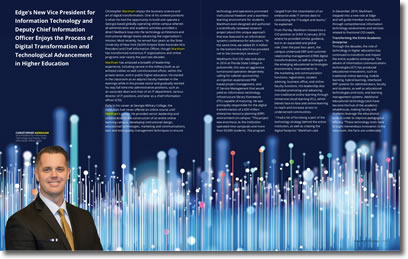Christopher Markham enjoys the business science and art of digital transformation. One of his coveted positions is when he had the opportunity to build and operate a Georgia-based globally operating online campus wherein all administrative and academic activities provided a direct feedback loop into the technology architecture and instructional design teams advancing the organization’s mission. Most recently, he served four years as the State University of New York (SUNY) Empire State Associate Vice President and Chief Information Officer, though Markham has transformed numerous IT organizations and online programs over nearly the past two decades.
Markham has amassed a breadth of leadership experience, including service in the military both as an enlisted soldier as well commissioned officer, within the private sector, and in public higher education. He started in the classroom as an adjunct faculty member in the evenings while in the private sector and gradually worked his way full time into administrative positions, such as an associate dean and chair of an IT department, various director of IT positions, and later as a chief information officer (CIO).
Early in his career at Georgia Military College, the institution had never offered an online course until Markham’s arrival. He provided senior leadership and collaboration in the construction of an entire online learning campus, developing instructional design, educational technologies, marketing and communications, lean and total quality management techniques to ensure technology and operations promoted instructional freedom and a seamless learning environment for students. Markham even designed and authored a scientifically reviewed research project about this unique approach that was featured in an information systems conference for educators. “At the same time, we added $1.4 million to the bottom line which has provided net to the University’s revenue.”
Markham’s first CIO role took place in 2014 at Florida State College in Jacksonville, this was an aggressive turnaround operation desperately calling for cabinet sponsorship, an injection experienced PMI based project management, and IT Service Management that would yield an information technology infrastructure library framework (ITIL) capable of maturing. He was principally responsible for the digital transformation of a $30 million enterprise resource planning (ERP) environment on campus. “The project was enormous as the institution operated nine campuses and more than 50,000 students. The program ranged from the instantiation of an enterprise wide IT service desk to centralizing the IT budget and teams,” he explained.
From Florida, Markham moved into a CIO position at SUNY in January 2016, where he provided similar guidance, but in an expanded and global role. Over the past four years, the campus undertook ERP and customer relationship management (CRM) digital transformations, as well as changes in the emerging educational technologies environment, improvements to the marketing and communication functions, registration, student advising, business office, and online faculty functions. His leadership also included promoting and advancing non-traditional online learning through immersive cloud learning (ICL), which blends face-to-face and online learning to reach and increase access to underserved communities.
“I had a lot of fun being a part of the technology strategy behind the entire institution, as well as creating the digital footprint,” Markham said.
In December 2019, Markham stepped into a new role at Edge and will guide member institutions through comprehensive information technology assessments and services related to fractional CIO needs.
Transforming the Entire Academic Enterprise
Through the decades, the role of technology in higher education has continued to transform and impact the entire academic enterprise. The advent of information communications technologies (ICT) has produced educational innovations, such as traditional online learning, mobile learning, hybrid learning, interfaced ERP systems for administrators, faculty and students, as well as educational technologies and tools, and learning management systems. Additional educational technology tools have become the hub of the academic wheelhouse, making faculty and students leverage the educational tools in order to improve pedagogical efficacy. “These technology tools have brought tremendous innovation to the classroom, the facts are undeniably true that the technology footprint is a critical element within the pedagogical activity and instructional freedom found in higher education,” Markham added.
The technological transformation is also why the CIO title has become a strategic role and often considered a cabinet-level position. “If the CIO position is viewed only as a call or cost center, then a reduction in overall performance is exactly what you’re going to get, both administratively and academically. Not empowering your CIO in the post-modern information age will mostly produce a glorified help desk. There should be no monopoly on thought leadership; the CIO should bravely contribute to thought leadership as much as any other executive in the boardroom. Non-technical executives who don’t take the time to understand the digital footprint along the student lifecycle will create an unsound economic environment and stifle creativity, in the long run. A cabinet level adoption of digital value will grant visibility across all the administrative processes and academic environments, will be able to leverage data to improve upon the student experience and success,” Markham said. “By providing a strategic technology footprint that spans the entire student life cycle, an institution can lower the total cost of ownership, increase return on investment, improve cybersecurity, and provide a rich environment for pedagogical efficacy.”
Seismic Shift in Digital Transformation
Higher education today continues to experience major shifts in digital transformation initiatives, partly due to globalization’s impact on colleges and universities. This demand is forcing higher education institutions to consider the overall cost of ownership and the return on investment (ROI) in the digital landscape, as well as technology’s footprint across the entire student life cycle. “Institutions that don’t respond in consideration of the total cost of ownership (TCO) and ROI, with the digital footprint across the entire student life cycle, will find themselves not competitive in the global market for higher education in the long run,” Markham said.
Digital transformation also includes modifications in organizational change management, business process modeling and reengineering project management, and enterprise information systems architecture. Edge assists growing member communities in all of these areas to properly adapt to their particular institutions and/or organizations. This ongoing process of digital transformation has also been changing the role of senior technology executives in higher education’s framework and methodology. “The real value of information in technology and information systems is not in the technology and systems themselves, but in the people of the organization who oversee the technology,” he said. “Digital humanities are at the very essence of modern day information systems and technology is at the core of digital humanities.”
The programs and systems in place provide the means to conduct the functions and are necessary soft skills for digital transformation. Markham reiterated, however, that if the right people aren’t in place, an IT system or organization won’t be anything more than a glorified data center. This area is one place Edge has devoted significant focus and can assist higher education institutions with the process. “Edge possesses the breadth and the depth of experience, knowledge, and capability in these necessary enterprise soft skills for digital transformation that many higher education institutions struggle to have the qualifications on staff,” Markham added.
“Edge possesses the breadth and the depth of experience, knowledge, and capability in these necessary enterprise soft skills for digital transformation that many higher education institutions struggle to have the qualifications on staff.”
Christopher Markham
Vice President for Information Technology and Deputy Chief Information Officer, Edge
Importance of Institutional Data Usage
Institutional data is playing a large role in decision-making in higher education, providing schools with information on how to increase enrollments, retentions, and graduation rates. The way data is used often yields a greater ROI than the actual physical infrastructure of an institution because of how the information can improve a student’s overall experience. Data gives visibility throughout all of the business processes and academic experiences of the student. Explained Markham, “Data is now the new oil and provides valuable information because the data exists for the entire student life cycle, from recruiting to retention and all the way through graduation.”
Another example of how IT management streamlines information is by including the gathered data into the framework of customer service and overall optimal efficiency. The information technologies infrastructure library framework (ITIL) is a set of practices that improve the IT organization at an institution and assists with the advancement of the school. “The process is really less about the technologies, but more about leveraging the right practices, such as ITIL. There are technologies on the market that can assist with this process and some tools are better than others,” he said. “Institutions are impossible to drive towards higher levels of IT service management (ITSM) maturity without the right technologies to support the technological practices.”
Employing a seasoned CIO is valuable to any organization, but not every Edge member has the luxury of this seasoned function at their disposal. This scenario is one of the reasons Markham was excited to join the Edge team. In his role, Markham will work closely with Edge’s membership to share his wide depth of experience, including the ability to assess an organization’s IT strategy, organizational structure, IT economics and finance, institutional data, emerging and educational technologies, IT governance and digital transformation capacity and capability, and cybersecurity in infrastructure.
Markham also noted that Edge partners with interested members and allows them to outsource management and liability of technology need, as well as combine tasks such as shared service and economies of scale, through mature cloud computing architecture and multi-tenant instance of enterprise technology solutions, so schools and organizations are able to increase ROI.
“Each member is instantiated individually so we can lower the cost, because we can negotiate a lower price point better than what they can do individually,” Markham said. “We can also take on the day-to-day management of the technology, as well as the risk from a cybersecurity standpoint and provide the solution back to members.”




